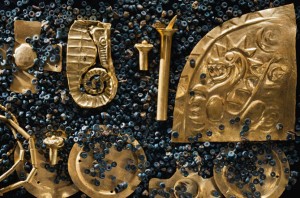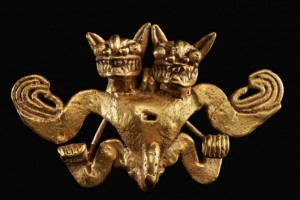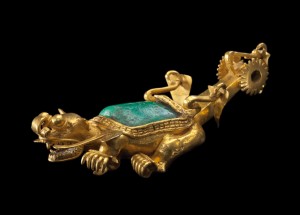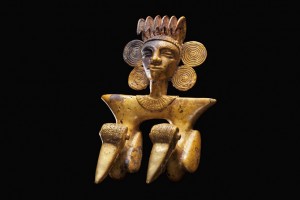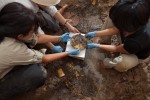 National Geographic has a fascinating feature story on an excavation that has literally struck gold, and huge amounts, in a 1200-year-old cemetery of the Sitio Conte peoples in Panama. Led by archaeologist Julia Mayo of the Smithsonian Tropical Research Institute in Panama City, the team began excavating the El Caño site in 2005 and by 2010 had found the gold-packed burial of a chieftain. That was just the beginning.
National Geographic has a fascinating feature story on an excavation that has literally struck gold, and huge amounts, in a 1200-year-old cemetery of the Sitio Conte peoples in Panama. Led by archaeologist Julia Mayo of the Smithsonian Tropical Research Institute in Panama City, the team began excavating the El Caño site in 2005 and by 2010 had found the gold-packed burial of a chieftain. That was just the beginning.
The team returned last year during the January-to-April dry season and unearthed a second burial every bit as rich as the first. Bearing two gold breastplates in front, two in back, four arm cuffs, and a luminous emerald, the deceased was surely another supreme chief. Near him lay a baby similarly adorned in gold, most likely his son. Beneath both of them stretched a layer of tangled human skeletons, possibly sacrificed slaves or war captives. Radiocarbon tests would date the burials to about A.D. 900—the era when the Maya civilization, some 800 miles to the northwest, was beginning to unravel.
Mayo barely had time to catalog the new finds before her team uncovered more gold. Glinting from the walls of the pit, the artifacts marked the edges of four more tombs. As she surveyed the scene, she couldn’t help but feel stunned. “I was just speechless—fascinated, but also worried,” she remembers. The rains had already begun, and she was now in a race to retrieve all the treasure before the neighboring river flooded the site. Also, she knew looters were sure to come if news of the discoveries got out. She swore her team to silence and prayed for clear skies.
The conquistadores encountered the Sitio Conte people in the 1500s and described their astounding array of gold armature and jewelry (while slaughtering them and taking said gold, of course). It appears that the culture changed very little between the time of the burials Mayo discovered and their descendants’ encounters with the pointy side of the Spanish invaders 700-500 years later. With the exception of some carved stone monoliths, the Sitio Conte didn’t build monumental or even modest but enduring architecture like other Mesoamerican peoples. They lived in bamboo huts and used stone tools, and annual floods have laid waste to organic remains.
At the same time, they had goldsmiths with an exceptional level of skill. This is why earlier archaeologists who studied the Sitio Conte sites in the 1930s and later thought that the gold artifacts must have been imports from more sophisticated neighboring cultures. Mayo’s team has proven definitely that this is not the case.
Specialists at the Smithsonian Institution are analyzing the array of materials Mayo’s team has unearthed and have already made a major discovery. Natural impurities in the gold indicate that the metal was mined and worked in the region. This firmly puts to rest any debate about whether Panama’s treasures were imported from farther south, where cultures were supposedly older and more advanced. The native people in this area may have lived in simple huts, but they were rich enough to support master craftsmen and sophisticated enough to appreciate fine art.
And how:
